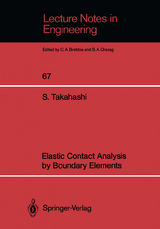Elastic Contact Analysis by Boundary Elements
1: Introduction.- 2: Overview of Contact Analysis.- 2.1 Introduction.- 2.2 Experimental Approach.- 2.3 Analytical Approach.- 2.4 Numerical Approach.- 2.5 Remarks.- 3: Boundary Elements Formulation in Elastostatics.- 3.1 Introduction.- 3.2 Governing Equations.- 3.3 Fundamental Solutions.- 3.4 Integral Equations.- 3.5 Boundary Integral Equations.- 3.6 Displacements and Stresses at Internal Points.- 3.7 Boundary Elements Discretization.- 4: Two-Dimensional Contact Analysis.- 4.1 Introduction.- 4.2 Contact Analysis between Elastic Body and Rigid Body.- 4.3 Contact Analysis betwene Elastic Bodies.- 5: Axisymmetric Contact Analysis.- 5.1 Introduction.- 5.2 Boundary Element Analysis.- 5.3 Contact Analysis.- 5.4 Numerical Application.- 6: Conclusions.- References.- Appendix I: Cartesian Tensor Notation.- Appendix II: Dirac Delta Function.- Appendix III: Hertz (Analytical) Solutions for Cylindrical and Axisymmetric Contact Problems.
| Erscheint lt. Verlag | 24.6.1991 |
|---|---|
| Reihe/Serie | Lecture Notes in Engineering |
| Zusatzinfo | VI, 217 p. |
| Verlagsort | Berlin |
| Sprache | englisch |
| Maße | 170 x 242 mm |
| Gewicht | 397 g |
| Themenwelt | Naturwissenschaften ► Physik / Astronomie ► Mechanik |
| Technik ► Bauwesen | |
| Technik ► Maschinenbau | |
| Schlagworte | Boundary element method • Elasticity • Elastizität • Kräfteermittlung • Randelementmethode • Randelementmethode / Boundary-Elemente • rigid body • Stress analysis |
| ISBN-13 | 9783540540106 / 9783540540106 |
| Zustand | Neuware |
| Informationen gemäß Produktsicherheitsverordnung (GPSR) | |
| Haben Sie eine Frage zum Produkt? |
aus dem Bereich




